Menu
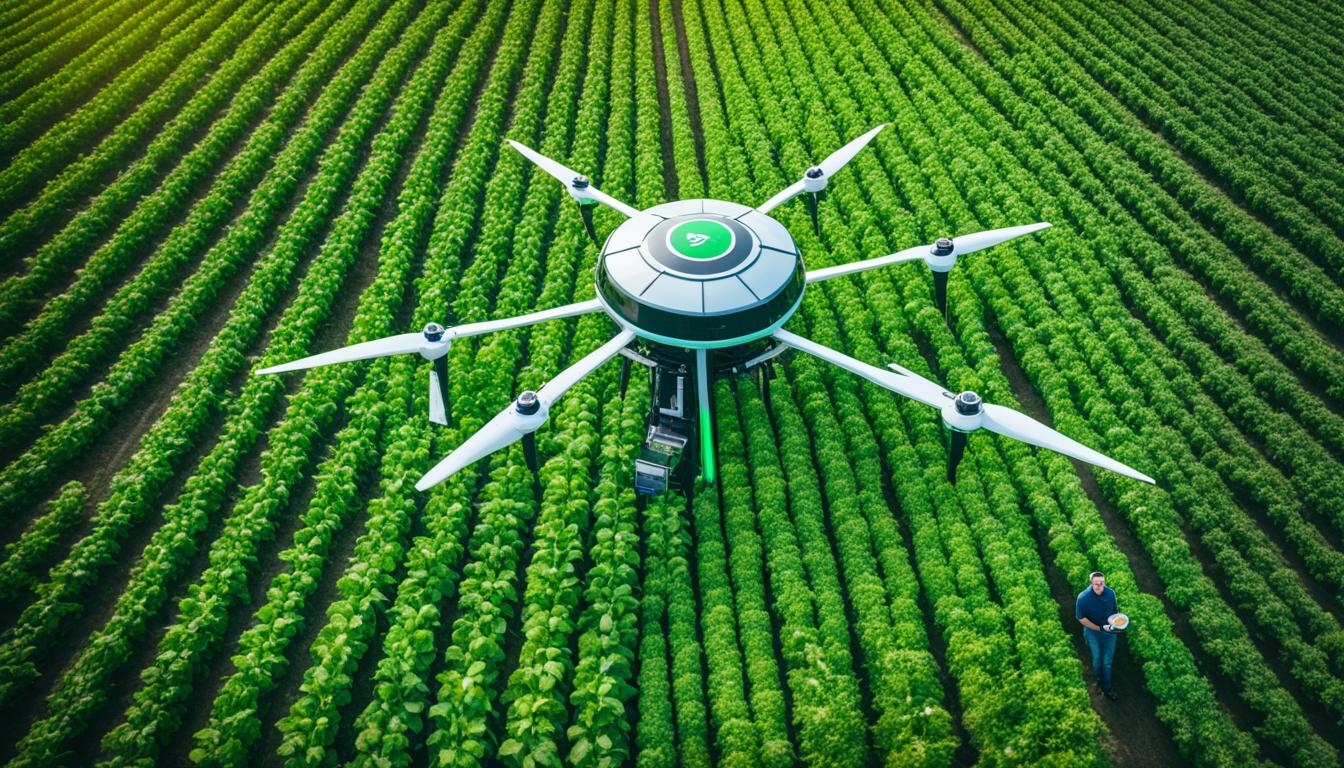
Since 2017, the adoption of AI has doubled. A survey by McKinsey in 2022 showed how big this growth is, especially in agriculture. Small farms are using AI to become better at marketing and running their operations. This isn’t just a trend. It’s a huge change in how we see technology in farming.
Right now, many farm marketers are using AI. A study by the Influencer Marketing Hub found that about 62% of them are. This shows that AI is really important for making small farms more competitive. Tools like Designs.ai, Qlik Sense, and Chatfuel are helping these farms save money and make more profit.
Artificial Intelligence (AI) is key in today’s agriculture, changing how farmers market and run their farms. With AI, farming becomes more efficient, using resources better. As AI advances quickly, its benefits for farm work grow, urging farmers to use it more.
AI involves using algorithms to understand data for helpful insights. This helps people work smarter by handling tough jobs for them. For farmers, AI means tools like Designs.ai, which makes managing social media and design easier.
AI brings big benefits to farming. It can find apple black rot with over 90% accuracy, cutting down on crop losses. Platforms like CattleEye spot health issues in cattle early with AI.
AI drones are also a plus, figuring out the exact pesticide amounts needed. This reduces waste and helps the environment. Plus, AI’s help in mapping yields, providing updates for better farm planning.
As farming faces more challenges, AI becomes crucial for success and keeping up with demand. It is now a must for smart and sustainable farming.
Farming’s role is vital with the world’s population set to hit 10 billion by 2050. The market for AI in farming is growing fast, showing its future importance.
| AI Application | Benefit |
|---|---|
| Apple Black Rot Detection | Over 90% accuracy in disease detection |
| CattleEye Monitoring | Health and behaviour monitoring with AI and ML |
| AI-powered Drones | Efficient pesticide application |
| Yield Mapping | Real-time analysis for better crop planning |
Precision agriculture is changing the way we farm. It uses new technologies to improve how we grow food. One key part is the use of Artificial Intelligence (AI). This gives us important information to make better decisions based on data.
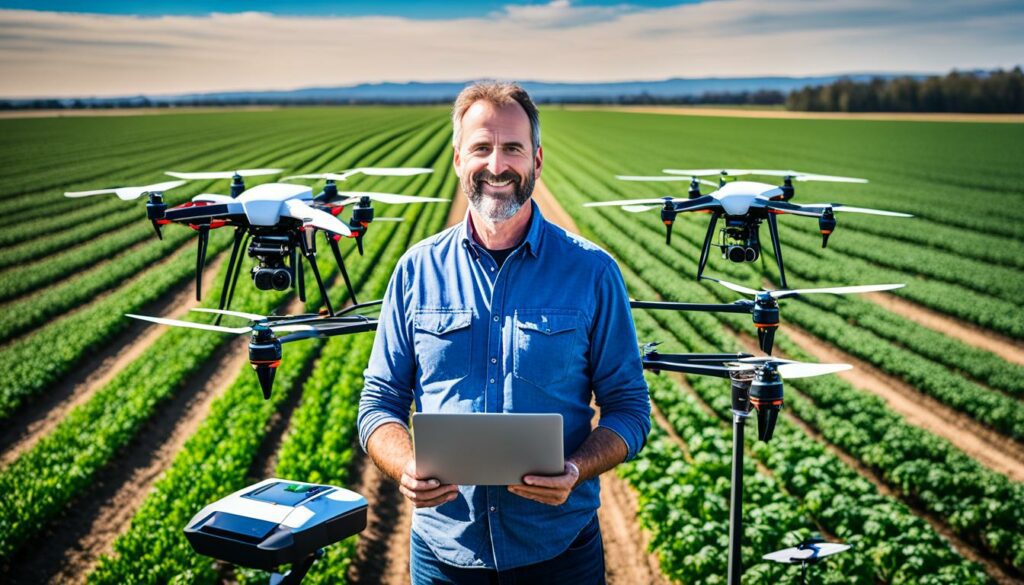
New tech like GPS, IoT sensors, AI, and machine learning is used in precision agriculture. It gathers data from the field in real-time. This information helps watch over farming tasks and make small but important changes.
For example, smart irrigation can check for leaks. This helps save water by fixing any problems quickly. Drones, powered by AI, fly over fields to look for pests and diseases. They can spot issues early, helping farmers act fast.
There are many tools for farming now. Things like Qlik Sense turn complex data into helpful advice for farmers. Even small farms can now use big data to make smart choices.
Driverless tractors and smart water systems are also making farming better. They lower mistakes and work more efficiently. AI saves money by boosting crop yields and cutting costs. This is why AI and precision agriculture are so important together.
The AI in agriculture market is really growing. It’s going from a market value of USD 1.7 billion in 2023 to USD 4.7 billion by 2028. AI is helping with things like water use, monitoring crops and soil, and looking after livestock. With the world needing to feed 10 billion people by 2050, these advances are key for a green future.
AI is changing how we monitor crops, using advanced tech to check plant health in amazing ways. With satellites, drones, and sensors, farmers learn a lot about their crops. They collect data on health, the soil, weather, and pests.
Machine learning quickly analyses this data, helping farmers make smart choices all year round. For example, drones take detailed pictures that show if plants need more nutrients or water. This helps farmers to care for their fields more effectively.
AI can also spot pests and diseases early. So, farmers can act fast, using less chemicals and helping the environment.
AI makes farming more efficient, saving water and fertiliser. This reduces the risk of polluting the environment and is better for the planet.
| Technology | Function | Benefits |
|---|---|---|
| Satellite Imagery | Monitor crop health, soil conditions | Identifies stress, deficiencies |
| Drones | High-resolution aerial imaging | Precision irrigation and fertilisation |
| IoT Sensors | Real-time data collection | Timely insights |
| Machine Learning Algorithms | Analyse data patterns | Early detection of issues |
| AI Predictive Analytics | Forecast yields | Optimised planting and harvesting |
Using AI to plant and rotate crops better, based on past data, helps crops grow more and keeps the soil healthy. This reduces waste and harm to the environment.
Data from satellites and drones is used by AI to quickly find and fix crop problems. AI can even find diseases in plants early, giving farmers a head start.
AI tools also make managing farms easier and more profitable. They offer advice based on data, making it easier to run a farm well.
AI isn’t only good for farms; it also helps sell products better. By making shipping more efficient, it cuts waste and boosts earnings. This is good for the farmers and the planet.
AI has changed farming by improving how we predict and manage crop yields. It brings new insights through predictive analytics and makes harvesting more efficient.
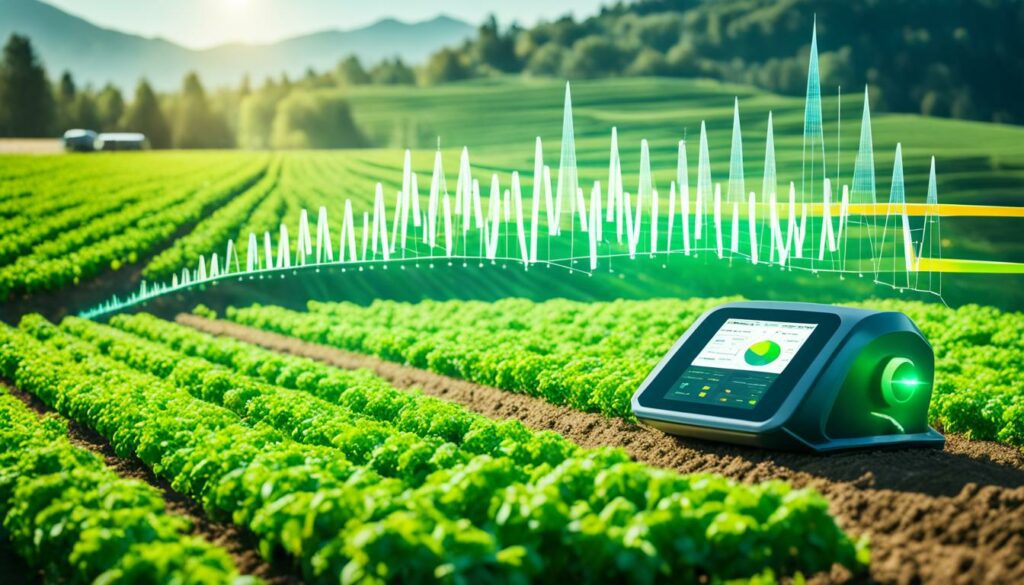
Using AI, we can predict how much crops will yield by looking at data on the weather, the soil, and the health of the crops. This helps farmers know what to expect and plan better for when to harvest. It also helps them match their produce with what the market needs, which can make them more money and reduce waste.
Choosing the right time to harvest is key for getting the best yield and quality. AI tools consider the weather and the state of the crops to suggest the perfect harvest time.
They also make sure the harvest meets market needs, making every crop as fresh as possible when it reaches the consumer. This approach boosts the efficiency of the whole harvest process.
Specialised software systems for agriculture help a lot with this. They handle everything from when to plant to how to use resources best. By bringing all these tasks together, they make farming more effective and up-to-date. This way, farmers can make choices that boost how much they produce and how efficient they are.
With AI’s help, farming companies can get more out of their harvests and work more sustainably. This tech not only predicts yields but also ensures that the harvest goes smoothly, leading to growth in the farming industry.
AI-driven farming is changing the face of agriculture. It brings new ways to be both more productive and kinder to our planet. With the world’s population expected to reach 10 billion by 2050, farming needs to step up. Technologies in smart farming are key for the future.
The use of AI in farming is set to grow massively, from USD 1.7 billion in 2023 to USD 4.7 billion by 2028. This growth is a big deal. It means technologies like precision agriculture will become more common. This tech helps farmers manage resources better and make more profit from their crops. By using AI, they can increase what they produce while saving money and resources.
Agribusiness technology relies on data to make good choices. With other tools, farmers get real-time info to use water more wisely, keeping farming sustainable. AI easily spots crop problems and pests, allowing farmers to act fast and save their harvests. This is thanks to sensors and smart tech that monitor fields.
Drones with AI can also improve how we use pest control. They can find the exact amount of pesticide needed, avoiding waste and harm to the environment. These new farming methods help both farms and the earth, making agriculture better for the future.
Smart farming isn’t just good for business. It’s good for the planet too. AI irrigation systems save water, which is crucial for the future of farming. Monitoring tools using AI also help farms run smoother, by keeping an eye on everything from how well machinery is working to predicting when things might break. Such smart tools make farming more efficient and sustainable.
In the end, AI in farming is all about the future. It helps farmers grow crops all year using less water. By doing so, smart farming is leading us towards a more sustainable and efficient way of farming for the future.
By 2050, the world’s population will likely be 10 billion. So, the farming industry needs to grow more food. Farm automation, powered by AI and robots, can help a lot. It lets farms do tasks like seeding and harvesting quicker and better.
Robots have changed farming a lot. Driverless tractors, for example, use smart programs to plant, fertilise, and harvest accurately. This not only makes things work faster but also makes fewer mistakes, leading to better crops.
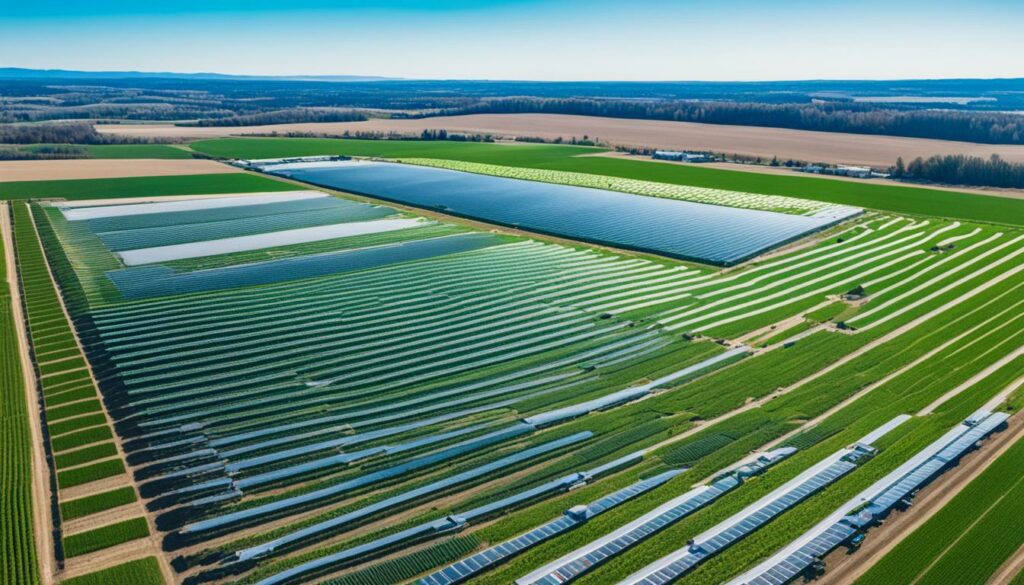
AI is now also helping in greenhouses. Special robots check on plants all the time. They look at the soil, water, and if any pests are around. This way, the plants always get what they need to grow well.
AI is great at doing boring jobs on farms. For example, drones and smart watering systems can handle watering and spraying crops on their own. This means farmers can focus on other important things.
There are even smart systems that can predict when to water. This saves water and is good for the environment. Drones help by showing what areas need more attention. This means only the right spots get extra water or care, saving resources.
| AI Technology | Application |
|---|---|
| Driverless Tractors | Autonomous navigation for planting and harvesting |
| Agricultural Drones | Precision targeting of irrigation and pesticide application |
| Greenhouse Robots | Monitoring and managing plant health |
| Smart Irrigation Systems | Efficient water management and leak detection |
Using AI for farm jobs has many benefits. It reduces the need for hard work from people. Plus, it makes farms more productive. With the AI market in farming set to grow, these changes are just beginning.
Today, modern farmers are relying more on data-driven insights. They use historical data analysis to boost their operations. This approach helps enhance their productivity and make better decisions.
Looking at past data is key to see long-term trends and plan well. Qlik Sense uses advanced technology to make data understandable. It turns complicated numbers into useful insights. This means farmers can understand a lot of data quickly, even without a tech background. So, it saves them time and effort.
Using data makes decision-making in farming much better. AI looks at things like soil, weather, and past crops to give planting and harvesting tips. For example, it helps predict what the market will need and suggest better planting times. These AI tools boost how well farms run and their profits a lot.
Farming with AI also spots risks and chances. By watching the weather and the crops, AI can find diseases or pests early. This lets farmers act before problems get big. So, they can prevent big losses and have healthier crops.
| Benefit | Details |
|---|---|
| Optimised Planting and Harvesting | AI analyses soil and weather data to recommend the best times for planting and harvesting. |
| Risk Mitigation | Early detection of diseases and pests through continuous monitoring. |
| Efficiency in Resource Use | Improves water and fertiliser management by providing accurate application schedules. |
| Enhanced Yield Prediction | Utilises past data and predictive analytics for precise yield forecasting. |
Data-driven farming with AI is transforming agriculture. Farmers making better decisions thanks to data. This leads to more efficient and productive farms.
Artificial intelligence (AI) in farming has changed how we grow food. It makes farming more efficient and helps the environment. It also helps farmers make more money.
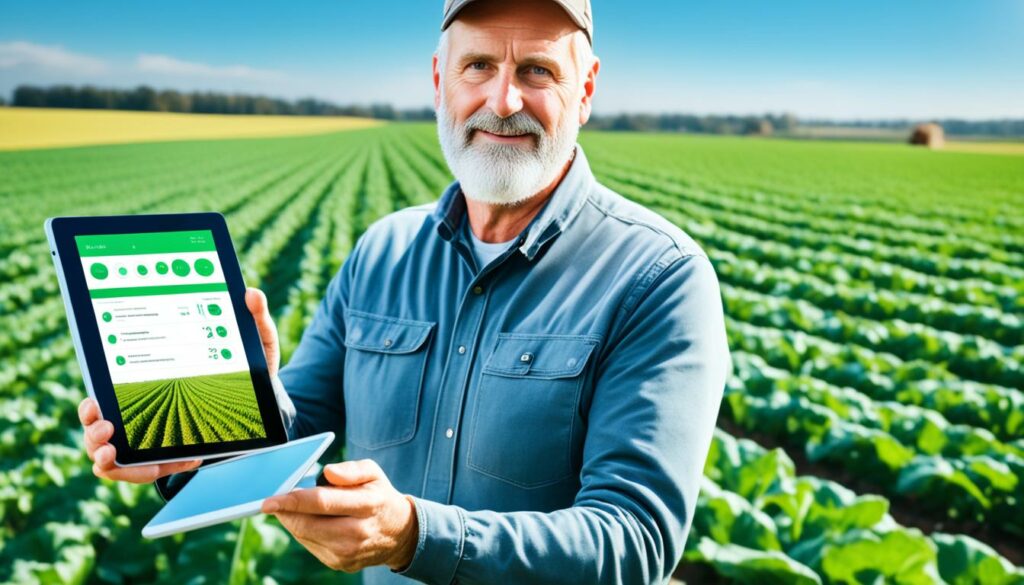
Small farmers benefit a lot from AI. Tracy Frey, from the Williamsburg Farmers Market, has seen its power. Tools like Constant Contact’s AI Content Generator help them market better. This means they reach more people with their produce.
AI isn’t just for marketing. It’s also used in machines that work on farms. These include self-driving tractors and robots in greenhouses. They help farms produce more while using fewer resources. This saves money and helps the planet.
Using AI in farming will only get more popular. By 2028, the market could be worth USD 4.7 billion. This is a big jump from USD 1.7 billion in 2023. Key AI technologies will keep growing. They make farming more precise and efficient over time.
“AI applications in precision farming have increased crop yields by 20-30% and reduced water usage by up to 25%,” emphasises the importance of AI in resource management.
In the coming years, we’ll use AI for even more on the farm. It will help with preventing pests, checking soil health, and improving crop yields. This is important for feeding more people as the world’s population grows.
| Growth Area | 2023 Market Size (USD Billion) | 2028 Market Size (USD Billion) | CAGR |
|---|---|---|---|
| AI in Agriculture | 1.7 | 4.7 | 25% |
| Yield Optimisation | 20-30% Increase | — | — |
| Future AI Impact | Reduced Water Usage | up to 25% | — |
In summary, AI is becoming essential in farming. It makes farming better and ensures we can grow enough food for everyone.
AI technology is making a big difference in farm marketing. Marketers are using AI to create strategies that get people and make money. A survey found that almost 62% of marketers are now using AI. This shows how important it has become.
Tools like Design.ai let farm businesses make things like images and videos for their ads. They are used in specific ads to really catch the eye of the right people. And with Qlik Sense, companies can look at data in a way that helps them make better ads.
AI helps marketers see how customers move online, collecting lots of useful data. This data is then used to make ads more personal. For example, AI can guess what’s going to be popular in the future. The Williamsburg Farmers Market is using AI to make their email newsletters more interesting. This has helped make more people want to read them.
Chatfuel is a service that creates chatbots. It helps companies talk to customers better. These chatbots also suggest products and learn about customers. This makes buying things easier for customers and keeps them happy.
The global population is set to hit 9.8 billion by 2050. Innovation in agriculture is now essential. AgTech solutions provide tools for farmers to address these challenges. They use advanced technologies, such as AI, for better market insights and price predictions.
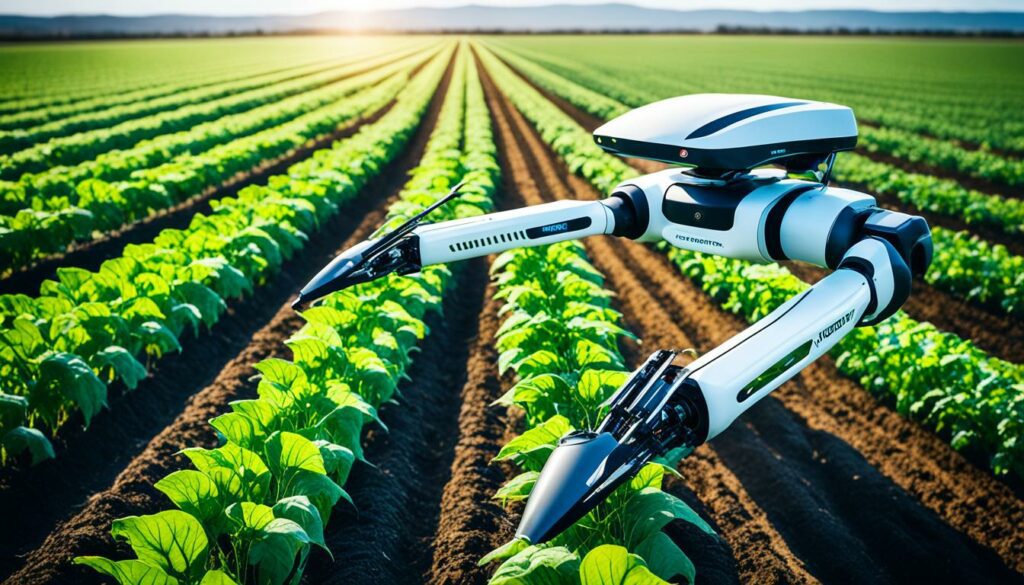
New technologies are changing farming. AI helps with predictions, automation, and spotting crop diseases early. It brings efficiency and smart planning to farms. Solutions like MentorMate offer personalised advice. This personalised service helps farmers make better decisions, leading to more crops.
Selecting the best AgTech for your farm involves looking at a few crucial points. AI automation provides up-to-the-minute data on crop health, resource use, and automates tasks. This makes farming more efficient. Precision farming uses AI too. It improves how we use water, fertiliser, and pesticides. This leads to less waste and better crop production.
A table below lists key things to think about when picking AgTech:
| Consideration | Importance | Example AgTech Tool |
|---|---|---|
| Ease of Use | Crucial for quick adoption, avoids lots of training for farmers | Growers’ Platform |
| Data-Driven Insights | Helps make smart choices by turning complex data into clear advice | Agmatix Data Hub |
| Automation Capabilities | Makes farming more efficient by doing hard work automatically | ICL’s Nova PeKacid |
| Predictive Analytics | Makes it easier to know when to plant and harvest, matches market needs | AngelaWeb 2.0 |
Choosing and using the right AgTech can really change things for the better. It’s all about being easy to use and making the most of AI for analysis and help. The future of farming with these innovations looks very bright.
Artificial Intelligence (AI) is changing the way we deal with pests and diseases in farming. With AI, farmers can find and manage these risks better. This leads to healthier crops and helps the environment because less chemical pesticides are used.
AI is making it easier for farmers to spot and deal with pests and diseases. For example, drones and camera traps check crops for early signs of trouble. Then, AI like Farm Business Network’s “Norm” helps apply pesticides exactly when and where they’re needed. This means less pesticide use, which is better for the earth.
Today, sustainable pest management is a big topic in farming. AI is crucial here. It helps reduce waste and boost harvests. With AI, farming can work non-stop, easing the workload in places without enough workers. For instance, FarmSense’s FlightSensor watches over crops all the time. It spots insect signals and collects environmental data. This data helps farmers make smart choices about their crops. By using AI in pest control, farmers are taking a step towards healthier and greener farming.
Soil health is vital for keeping agriculture sustainable. With AI in soil health management, we’re able to monitor and improve soil quality. This leads to farming practices that are better for the environment and our future needs.
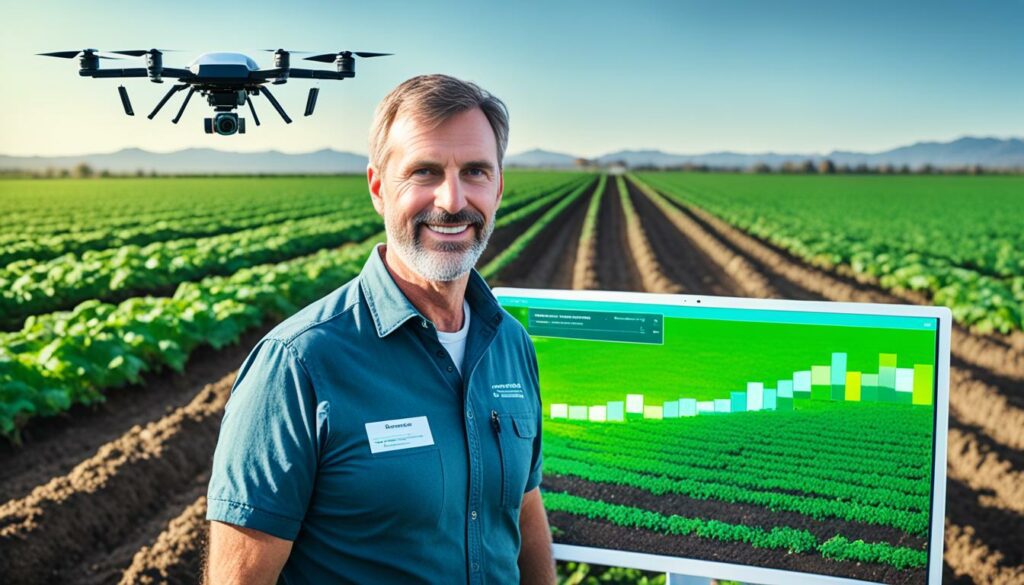
AI is changing how we check on soil quality. It can predict soil texture accurately, helping farmers decide what to plant. The U.S. Department of Agriculture is even using AI to measure soil moisture and improve irrigation by 50%. These new tools make sure we take good care of our soil, keeping it healthy for years to come.
Getting nutrient management right is key to good crop yields. AI tools help by giving real-time data and advice on nutrients. With AI, farmers can know exactly when and how much fertiliser to use. This approach boosts soil fertility and crop growth without harmful overuse.
| Statistic | Detail |
|---|---|
| Population Growth | Global agriculture needs to produce enough food to feed 10 billion humans by 2050. |
| Maize Production | Set to decrease by 24% by 2030, impacting food security. |
| AI Market Growth | Estimated to grow from $1.37 billion in 2022 to more than $11.13 billion by 2032. |
| Increase in Irrigation Efficiency | AI-based radar can potentially increase irrigation efficiency by 50%. |
| Challenges | High costs and lack of accessibility for smaller farms make AI adoption challenging. |
The coming together of artificial intelligence and agriculture is changing how we predict market trends and consumer needs. AI algorithms can look through huge amounts of data instantly. This gives agribusinesses new and detailed insights into market changes.
With the global population getting closer to 10 billion by 2050, agriculture must produce more efficiently. The field of AI in agriculture was worth USD 1.7 billion in 2023, and it’s set to jump to USD 4.7 billion by 2028. This rapid growth shows how important AI’s trend analysis is for pushing the industry ahead. By looking at past and present data, algorithms can forecast market movements. This helps farmers adjust their plans ahead of time.
AI gives farmers the power to predict what consumers will want, even as those desires change quickly. For example, AI-driven tools can see market trends and adjust production to meet what customers need. This not only makes managing stock better but it also stops waste, promoting sustainable farming. Reports show that using AI for guessing consumer demand has made farming more efficient and raised profits.
Also, AI is boosting resource efficiency, saving costs, and making farming more profitable. The market for agriculture AI is expected to hit USD 5.76 billion by 2029, growing at a rate of 22.55%. Tools like driverless tractors and drones make farm work smoother and more accurate.
| AI in Agriculture Growth | Statistics |
|---|---|
| Market Size (2023) | USD 1.7 billion |
| Projected Market Size (2028) | USD 4.7 billion |
| CAGR (2024-2029) | 22.55% |
| Major Markets | North America (Largest), Europe (Fastest Growing) |
| Key Players | Microsoft Corporation, IBM Corporation, Granular Inc., aWhere Inc., Prospera Technologies Ltd. |
Using AI trend analysis, I get key insights for guessing market trends and consumer needs. These abilities are crucial for planning marketing strategies and making sure agricultural products fit market demands.
Integrating artificial intelligence (AI) into agribusiness is changing how customers are served. AI helps tailor services to meet each customer’s needs. This makes customers happier and helps agribusinesses work more smoothly.
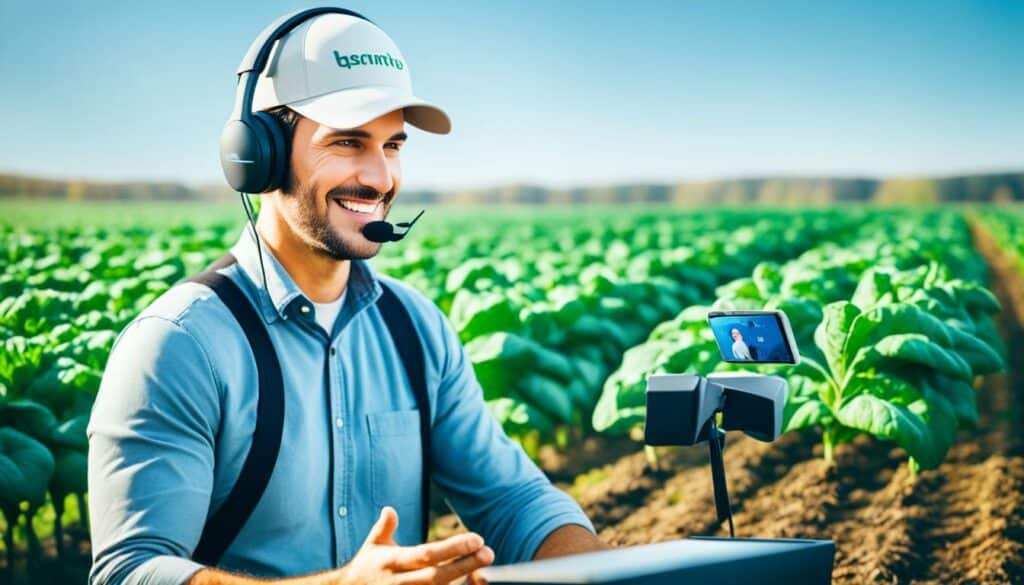
Today, customising how we interact with customers is key. AI is great at understanding online shopper habits. It helps in crafting marketing that truly speaks to people. This means when you shop online, the suggestions might be just what you need.
Market research shows 62% of marketers see the value in AI for this. Through AI, businesses can offer products, prices, and deals that feel tailored. This makes the shopping experience better for everyone.
AI-driven chatbots, like Chatfuel, are changing the game for agribusiness. They provide quick customer service round the clock on social media. These chatbots handle many customer questions without needing a person there. Thanks to AI, businesses have found they get more orders, making customers and the company happier.
| Service | Function | Impact |
|---|---|---|
| Designs.ai | Automates marketing tasks | Reduces time investment |
| Qlik Sense | Provides data analytics | Enhances decision-making |
| Chatfuel | Automated customer interactions | Increases engagement |
Agribusinesses are using AI to become more responsive and customer-focused. By employing AI, they can make their customer service sharper. This helps them stand out in today’s tough market.
The use of AI in farming is making a big difference in how things are done. It’s leading us towards ways that are better for the environment, use fewer resources, and put the customer at the heart of it all. As the world’s population grows and we need more food, high-tech farming is becoming more important. The AI in farming market is expected to triple, going from USD 1.7 billion in 2023 to USD 4.7 billion by 2028. This shows that farming is really changing with technology, for the better.
AI tools are changing how we farm in many ways. For example, drones can spot pests very accurately, and they can help with watering fields at just the right times. They also keep an eye on how crops are growing and when they’re ready to be picked. This means farmers can know about problems early and keep their crops and animals healthy.
AI helps farmers plan better and use their land more effectively. For instance, robots are working non-stop to take care of the fields and watch out for problems. Drones, with their cameras and sensors, are helping with crop management too. These technologies are making farming more precise and efficient than ever before.
AI can even sort fruits and vegetables by their sizes, shapes, and colours. This helps reduce waste and make sure the products we buy look great. AI is also used in checking the quality of food packaging and processing. This means less waste and better snacks for us. Ultimately, AI makes food shopping more personal, leading to better food and less waste.
As AI gets better, it’s helping with big challenges like keeping our food safe, using resources wisely, and combating climate change. Moving towards more AI in farming isn’t just a dream; it’s something we really need for a sustainable food future. I’m sure that farming’s future is bright with AI tech, making it more efficient and better for everyone.Together, AI and farming can create a world where we have enough food, use what we need wisely, and take care of our planet.
AI farm marketing uses technology to make marketing agricultural products better. It does this by using smart programs to automate tasks and make marketing more effective. Predictive analytics help to focus marketing on what customers want.
In precision agriculture, intelligent tools like Qlik Sense are used. They help farmers manage their resources better and get useful insights from data. These tools make it easier to handle things like nutrients, pests, and monitor crops.
Smart farming uses AI to work better, use fewer resources, and be greener. It combines smart tools, data analysis, and new ways to serve customers. This helps farmers do their jobs well and stand out in the market.
AI makes crop monitoring better with apps that check soil and crop health. These tools give farmers quick advice by spotting problems early. They help farmers use resources wisely and stop small issues before they get big.
AI helps get the best crop yield by using data to make smart guesses. It looks at weather, soil, and the health of crops. With this info, farmers can plan the best time to harvest and how to store the crops.
Farm automation uses smart machines to do jobs faster. It includes machines that work the land, drones that watch over crops, and even bots that talk to customers. All these save time and energy for farmers.
Data farming makes decisions better with the help of past information and learning machines. Tools like Qlik Sense help turn data into images that farmers can understand. With these tools, farmers can plan smartly and make good choices using detailed data.
Real-world AI in farming includes tools for watching over crops, guessing how much crop to expect, and marketing with AI’s help. These tools let small farms work better and keep up with bigger farms.
AI makes marketing personal by studying what customers like and do. Then it designs ads or messages just for them. AI even helps make the ads and messages so they change to fit different people without much work.
AgTech means using new tech to help farm better. This includes smart tools, AI for watching over crops, and machines to work by themselves. These make advanced farming techniques available to even small farmers, helping them compete with big farms.
In keeping pests and diseases away, AI helps by spotting problems early. This early warning lets farmers act fast and use less harmful chemicals. It means healthier farms and less harm to the environment.
AI is key in looking after the ground for farming. It recommends how to feed and water the soil. This keeps the soil strong and supports growing a lot of food sustainably.
AI looks at the market data and guesses what customers will want. These guesses help farmers prepare and market their goods smarter. It’s a way to get ready for what’s next and sell more.
AI makes talking to customers more personal and quick, especially with platforms like Chatfuel. It lets customers chat and get help without waiting. This makes buying and learning about farm products easier and more fun.